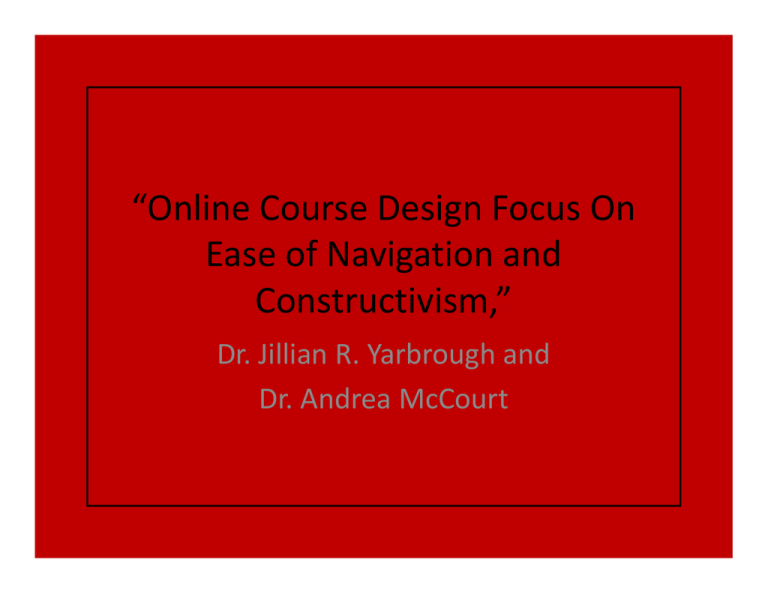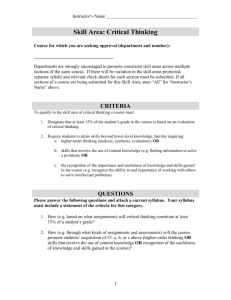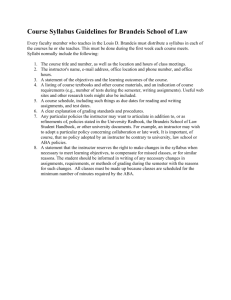“Online Course Design Focus On Ease of Navigation and Constructivism,” Dr. Jillian R. Yarbrough and
advertisement

“Online Course Design Focus On Ease of Navigation and Constructivism,” Dr. Jillian R. Yarbrough and Dr. Andrea McCourt Agenda • Introductions • Definition of a “comfortable” online course. • Definition of “comfortable” online courses within the same program. • Why “comfort” in the online classroom is important. • Tips/Strategies/Advice‐ Ease of Navigation. • Tips/Strategies/Advice‐ Constructivism. Online Course Design Disasters….. Online courses require unique strategy and experience and effective course design can greatly affect student learning outcomes (Sowan and Jenkins, 2013). What makes someone feel “comfortable” or at ease in an online course? A “comfortable” course includes….. • Ease of navigation. • Constructivism. Mariola and Manley, 2002 Ease of Navigation Helps Students: ‐ Engage in the class immediately ‐ Feel confident that they know what to do & how to do it ‐ Spend their time on learning rather than figuring things out Syllabus Thorough Emailed at least a week before class starts Posted in Classroom Restate University Policies States Course Policies and Expectations Qualitative and Quantitative Assignment Descriptions • Syllabus Order Matches Online Classroom Order • • • • • • Permanent Instructor Contact Tab or Link • Permanent Tab or Link that is always visible providing instructor and department contact information. Question and Answer Forum • Highly visible Question and Answer Thread. • Instructor response within 24 hours. • Encourage students to support each other. Types of Class Announcements • Permanent start of the semester announcements (preferred contact method, Technical Support contact info, etc.) • Consistency (post every Monday, etc.) • Guidance on assignments as needed • Fun Facts and Quotes • Wrap Ups of weekly discussion or major projects • Answers to Common Questions • Solutions Online Discussions Consistent number of discussions per week. Standard discussion thread location. Regular grading criteria (use a rubric, etc.). Qualitative and quantitative guidance/feedback. • Instructor visibility in discussion. • Support student directed discussions. • • • • Assignments • Consistent location. • Consider a single location for assignment details (syllabus only rather than syllabus & dropbox) • Qualitative and quantitative descriptions (for example, show the rubric and assignment description). • Consistent submission strategies (always due on the same day of the week, etc.). Grading and Feedback • Consistent grading time frame. • Be willing to answer follow up questions. • Make sure grading is clearly aligned with syllabus. But, many developers stop short of also designing a course that supports learner‐ centered instruction. Learner‐centered pedagogy minimizes “ready‐made” knowledge and supports student discovery and development of their knowledge (Stefanov and Nikolov, 1998). Constructivism • Constructivism is a theory of knowledge that argues that humans generate knowledge and meaning from an interaction between their experiences and their ideas. • This learning paradigm posits that learning in an active, constructive process where the learner creates knowledge. www.learning‐theories.com Constructivism • Students benefit when they construct: – – – – their own understanding and their own knowledge of the world through experience and then Reflecting on those experiences This can be accomplished in the online classroom Constructivism in Online Discussion • Ask students to generate innovative solutions to real‐world problems • Encourage students to reflect on personal or professional experiences that relate to course materials • Require students to analyze scenarios • Allow student to identify a “best” theory or solution and defend their answer Constructivist Assignments • Case studies (create solutions) • Journals or blogs (reflect on learning) • Field‐related experiences (observe a certain environment then interpret their observations) • Reflect on virtual field trips • Community service or service learning Constructivist Assignments • Group work (using threaded discussion, Bb Collaborate, Lync, Google Hangouts, etc.) • Problem‐based learning (what do you know, what do you need to find out, what should you do to solve this problem?) Multimedia • Different types of media can help student experience new environments • NBC Learn (advantage of being accessible) • Youtube Clips • Virtual tours Last Thoughts on Constructivist Assignments Versus Traditional Ones • Identify current issues or problems rather than topics • Propose solutions • Echo the deliverables in your profession • Apply a solution in the community • Reflect upon personal experiences rather than study others’ lives/ideas Identify One Way to Enhance Students’ Comfort in Online Courses References Alexander, J.W., Polyakova‐Norwood, V., Johnston, L.W., Christensen, P., & Loquist, R. S. (2003). Collaborative Development and Evaluation of an Online Nursing Course. Distance Education, 24(1), 41. Braun, T. (2008). Making a choice: The Perceptions and Attitudes of Online Graduate Students. Journal of Technology and Teacher Education, 16(1): 63‐92. Kress, H., Thering, A., Lalonde, C., Kim, S., & Cleeton, L. (2012). Faculty Reflections on Online Course Development and Implementation for Teacher Education. International Journal of Technologoy, Knowledge & Society, 8(1), 73‐83. Muilenburg, L.Y., & Berge, Z.L. (2005). Student Barriers to Online Learning: A Factor Analytic Study. Distance Education, 26(1), 29‐48.








